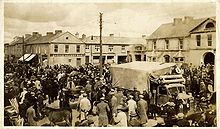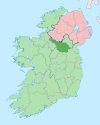- Arvagh
-
Arvagh (Irish: Ármhach, meaning "Battlefield") or Arva, is a town in County Cavan, Ireland, on the shores of Garty Lough and overlooked by Bruse Hill[1]. It is a scenic town situated in the centre of the drumlin belt. It lies on the border of Counties Longford and Leitrim and is famous as the town where the three provinces of Ulster, Leinster and Connacht meet[2].
Contents
Facilities
- Arvagh has a hotel, the Breffni Arms Hotel, with a restaurant, bar, nightclub, swimming pool, spa, gym and there are several pubs in the town, many of which have music at the weekends[2].
History
The Arvagh area was settled by Scottish planters in the early 17th century. A story is told that one of them, John Brown, sold the land here for a horse. The Earls of Gosford, the descendants of the man who bought it, developed the town in the early 19th century, building a Market House which is still standing[3]. In 1841 there were four pubs in the town and the monthly fairs were of considerable local trade importance[1].
Ármhach (meaning "Place of Slaughter") was brought about because Arvagh is on the borders of 3 counties and provinces, Leitrim, Longford and Fermanagh (Connaght, Leinster and Ulster). The royal families of these counties would battle in Arvagh and as a result many died, Hence "Place of Slaughter".
Events
- The Annual Breffni Challenge 20 km run takes place from Cavan and finishes in Arvagh every August, with all proceeds going to St. Luke's Hospital in Dublin[2]. www.breffnichallange.com
- Each year the Arvagh Agricultural Show takes place in the town[2]. www.arvashow.com
Places of interest
- Arvagh Market House is a nine-bay, two-storey building built before 1837 by the Earl of Gosford. It may have been designed by W D Butler. The outer six bays have been greatly altered and appear now as two three-bay houses[4].
- Nearby Bruse Hill is a small hill topped with three stone cairns, dating from the Neolithic period[2].
Angling
The area is very popular for fishing and lakes such as Hollybank, Gulladoo and Rockfield offer excellent angling all year round. The Arvagh International Fishing Festival takes place in Arvagh every September[2].
Demography
In the 1841 Census Arvagh had a population of 615[1].
People
William H. Bleakley (1888–1929), born in Arvagh, went to America in 1905. He was a pioneer of aviation and was the first to perform the aerobatic feat of looping the loop[3]. He attempted to set an altitude record in 1928 and crashed and died in 1929[5].
See also
References
- ^ a b c O'Neill, Kevin (2003). Family and Farm in Pre-Famine Ireland. University of Wisconsin Press. pp. 29–30. ISBN 0299098443.
- ^ a b c d e f "Arva". Cavan Tourism. http://www.cavantourism.com/html/towns_villages/arva.asp. Retrieved 9 March 2009.
- ^ a b "Arvagh - County Cavan". Discover Ireland. http://www.discoverireland.com/us/ireland-places-to-go/placefinder/a/arvagh-cavan/. Retrieved 9 March 2009.
- ^ "Arvagh Market House". Irish Antiquities. http://irishantiquities.bravehost.com/cavan/arvagh/arvaghMH.html. Retrieved 9 March 2009.
- ^ "William H Bleakley". Early Aviators. http://www.earlyaviators.com/ebleakle.htm. Retrieved 9 March 2009.
Coordinates: 53°55′N 7°35′W / 53.917°N 7.583°W
Places in County Cavan County town: Cavan Towns Villages Agharaskilly • Aghavoher • Arvagh • Ballinagh (Bellananagh) • Ballyconnell • Ballyhaise • Ballymagauran • Ballymagovern • Bawnboy • Berrymount • Blacklion • Butlersbridge • Canningstown • Cavanagh • Cloncollow • Crossdoney • Cullyleenan • Derryginny • Dowra • Kilcogy • Killashandra • Kilnacreeva • Kilnaleck • Lisnahederna • Milltown • Mountnugent • Mullagh • Mullaghduff • Rakeelan • Redhills • Stradone • SwanlinbarLandforms Black Pig's Dyke • Dún na Rí Forest Park • Glengevlin • Lough Gowna • Lough Oughter • Lough Ramor • Lough Sillan • Magh Slécht • Shannon Cave • Shannon Pot • Slieve Cuilcagh • Slieve RushenCategory:Geography of County Cavan Categories:- Towns and villages in County Cavan
Wikimedia Foundation. 2010.


